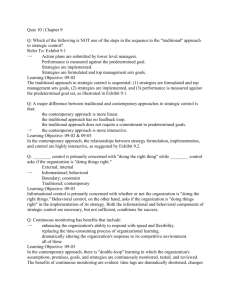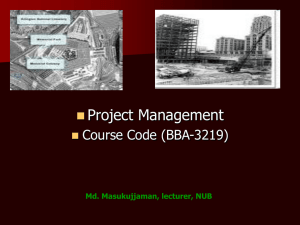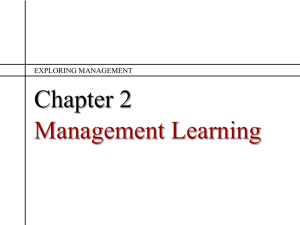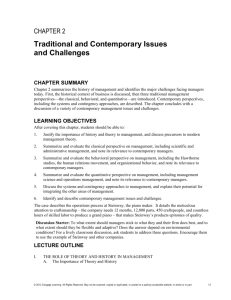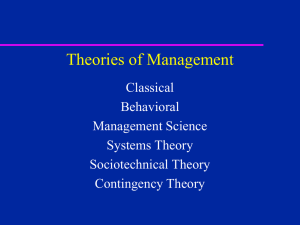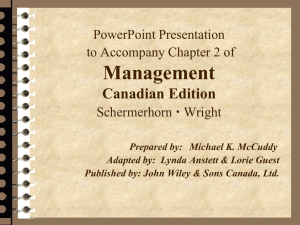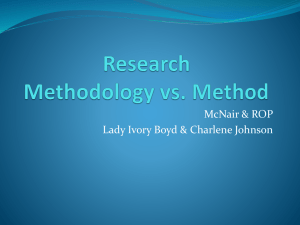Ch02 Traditional and Contemporary Issues and Challenges
advertisement
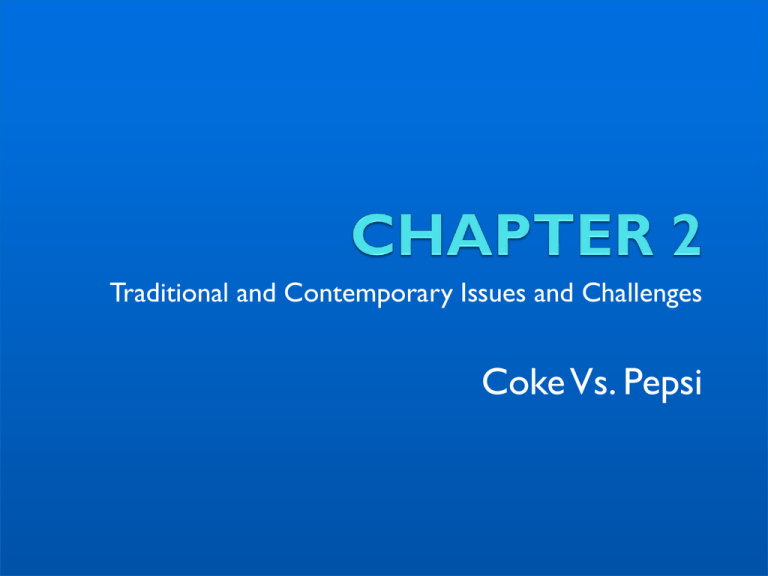
Traditional and Contemporary Issues and Challenges Coke Vs. Pepsi The Importance of Theory and History Why Theory? A theory is a conceptual framework for organizing knowledge and providing a blueprint for action. Management theories, used to build organizations, are grounded in reality. Most managers develop their own theories about how they should run their organizations. Why History? An awareness and understanding of important historical developments in management are also important to contemporary managers in furthering the development of management practices and in avoiding the mistakes of others in the past. 2–2 Precursors of Management Theory Management in Antiquity D Greeks C Babylonians G Venetians B Egyptians E Romans A Sumerians 3000 B.C. 2500 B.C. F Chinese 2000 B.C. 1500 B.C. 1000 B.C. 500 B.C. A.D.500 A.D.1000 A.D.1500 A Used written rules and regulations for governance E Used organized structure for communication and control B Used management practices to construct pyramids F Used extensive organization structure for government agencies and the arts C Used extensive set of laws and policies for governance D Used different governing systems for cities and state G Used organization design and planning concepts to control the seas Figure 2.1 2–3 Early Management Pioneers Robert Owen (1771–1858) British industrialist who was one of the first managers to recognize the importance of human resources. Implemented better working conditions, set a minimum age for child labor, provided meals, and reduced work hours. Vs. Factory workers as machines Charles Babbage (1792–1871) Noted English mathematician who focused on creating efficiencies of production through the division of labor, cooperation between management and labor, and the application of mathematics to management problems. Wrote “On the Economy of Machinery and Manufactures.” Quantitative management 2–4 Classical Management Perspective Consists of two different viewpoints: Scientific Management Concerned with improving the performance of individual workers (i.e., efficiency). Grew out of the industrial revolution’s labor shortage at the beginning of the twentieth century. Administrative Management A theory that focuses on managing the total organization. 2–5 Scientific Management Frederick Taylor (1856–1915) Considered the “Father of Scientific Management.” Replaced old rule-of-thumb methods of how to do work with scientifically-based work methods to eliminate “soldiering” where employees deliberately worked at a pace slower than their capabilities. Believed in selecting, training, teaching, and developing workers. Used time studies of jobs, standards planning, exception rule of management, slide-rules, instruction cards, and piece-work pay systems to control and motivate employees. 2–6 Steps in Scientific Management 1 Develop a science for each element of the job to replace old rule-of-thumb methods 2 Scientifically select employees and then train them to do the job as described in step 1 3 Supervise employees to make sure they follow the prescribed methods for performing their jobs 4 Continue to plan the work, but use workers to get the work done Figure 2.2 2–7 Classical Management Perspective Other Scientific Management Pioneers Frank and Lillian Gilbreth Reduced the number of movements in bricklaying, resulting in increased output of 200%. Cheaper by Dozen Henry Gantt Was an early associate of Fredrick Taylor. Developed other techniques, including the Gantt chart, to improve working efficiency through planning/scheduling. Harrington Emerson Advocated job specialization in both managerial and operating jobs. 2–8 Classical Management Perspective (cont’d) Administrative Management Theory Focuses on managing the whole organization rather than individuals. Henri Fayol Wrote “General and Industrial Management.” Helped to systematize the practice of management. Was first to identify the specific management functions of planning, organizing, leading, and controlling. Improve Managerial Effectiveness 2–9 Classical Management Proponents Lyndall Urwick Integrated the work of previous management theorists. Max Weber His theory of bureaucracy is based on a rational set of guidelines for structuring organizations. Chester Barnard Wrote “The Functions of the Executive.” Proposed a theory of the acceptance of authority (by subordinates) as the source of power and influence for managers. 2–10 Classical Management Perspective…Today Contributions Laid the foundation for later developments. Identified important management processes, functions, and skills. Focused attention on management as a valid subject of scientific inquiry. Limitations More appropriate approach for use in traditional, stable, simple organizations. Prescribed universal procedures that are not appropriate in some settings. In some cases, employees are viewed as tools rather than as resources. 2–11 Behavioral Management Perspective Behavioral Management Emphasized individual attitudes and behaviors, and group processes. Recognized the importance of behavioral processes in the workplace. Hugo Munsterberg (1863–1916) A German psychologist, considered the father of industrial psychology, wrote “ Psychology and Industrial Efficiency,” a pioneering work in the practice of applying psychological concepts to industrial settings. 2–12 Behavioral Management Perspective … The Hawthorne Studies Conducted by Elton Mayo and associates at Western Electric (1927–1935) Illumination study—changes in workplace lighting affected both the control group and the experimental group of production employees. Group study— the effects of a piecework incentive plan on production workers. Workers established informal levels of acceptable individual output. Over-producing workers were labeled “rate busters” and underproducing workers were considered “chiselers.” Interview program Confirmed the importance of human behavior in the workplace. 2–13 Behavioral Management Perspective … Human Relations Movement Grew out of the Hawthorne studies. Proposed that workers respond primarily to the social context of work, including social conditioning, group norms, and interpersonal dynamics. Assumed that the manager’s concern for workers would lead to increased worker satisfaction and improved worker performance. Abraham Maslow Advanced a theory that employees are motivated by a hierarchy of needs that they seek to satisfy. Douglas McGregor Proposed Theory X and Theory Y concepts of managerial beliefs about people and work. 2–14 Theory X and Theory Y Theory X Assumptions People do not like work and try to avoid it. People do not like work, so managers have to control, direct, coerce, and threaten employees to get them to work toward organizational goals. People prefer to be directed, to avoid responsibility, and to want security; they have little ambition. Theory Y Assumptions People do not naturally dislike work; work is a natural part of their lives. People are internally motivated to reach objectives to which they are committed. People are committed to goals to the degree that they receive personal rewards when they reach their objectives. People seek both seek responsibility and accept responsibility under favorable conditions. People have the capacity to be innovative in solving organizational Table 2.2 problems. 2–15 Organizational Behavior A contemporary field focusing on behavioral perspectives on management. Draws on psychology, sociology, anthropology, economics, and medicine. Important topics in organizational behavior research: Job satisfaction and job stress Motivation and leadership Group dynamics and organizational politics Interpersonal conflict The design of organizations 2–16 Behavioral Management Perspective…Today Contributions Provided important insights into motivation, group dynamics, and other interpersonal processes. Focused managerial attention on these critical processes. Challenged the view that employees are tools and furthered the belief that employees are valuable resources. Limitations Complexity of individuals makes behavior difficult to predict. Many concepts not put to use because managers are reluctant to adopt them. Contemporary research findings are not often communicated to practicing managers in an understandable form. 2–17 Quantitative Management Perspective Quantitative Management Emerged during World War II to help the Allied forces manage logistical problems. Focuses on decision making, economic effectiveness, mathematical models, and the use of computers to solve quantitative problems. Management Science Focuses on the development of representative mathematical models to assist with decisions. Operations Management Practical application of management science to efficiently manage the production and distribution of products and services. 2–18 Quantitative Management Perspective…Today Contributions Developed sophisticated quantitative techniques to assist in decision making. Application of models has increased our awareness and understanding of complex processes and situations. Has been useful in the planning and controlling processes. Limitations Quantitative management cannot fully explain or predict the behavior of people in organizations. Mathematical sophistication may come at the expense of other managerial skills. Quantitative models may require unrealistic or unfounded assumptions, limiting their general applicability. 2–19 Integrating Perspectives for Managers Systems Perspective A system is an interrelated set of elements functioning as a whole. Open system An organization that interacts with its external environment. Closed system An organization that does not interact with its environment. Subsystems The importance of subsystems is due to their interdependence on each other within the organization. 2–20 The Systems Perspective of Organizations Inputs from the environment: material inputs, human inputs, financial inputs, and information inputs Transformation process: technology, operating systems, administrative systems, and control systems Outputs into the environment: products/services, profits/losses, employee behaviors, and information outputs Feedback Figure 2.3 2–21 Systems Perspective Synergy Subsystems are more successful working together in a cooperative and coordinated fashion than working alone. The whole system (subsystems working together as one system) is more productive and efficient than the sum of its parts. Entropy A normal process in which an organizational system declines due to failing to adjust to change in its environment Entropy can be avoided and the organization re-energized through organizational change and renewal. 2–22 The Contingency Perspective Universal Perspectives Include the classical, behavioral, and quantitative approaches. Attempt to identify the “one best way” to manage organizations. The Contingency Perspective Suggests that each organization is unique. The appropriate managerial behavior for managing an organization depends (is contingent) on the current situation in the organization. 2–23 The Contingency Perspective (cont’d) An Integrative Framework Is a complementary way of thinking about theories of management. Involves the recognition of current system and subsystem interdependencies, environmental influences, and the situational nature of management. 2–24 An Integrative Framework of Management Perspectives Systems Approach • Recognition of internal interdependencies • Recognition of environmental influences Classical Management Perspectives Methods for enhancing efficiency and facilitating planning, organizing, and controlling Contingency Perspective • Recognition of the situational nature of management • Response to particular characteristics of situation Behavioral Management Perspectives Insights for motivating performance and understanding individual behavior, groups and teams, and leadership Quantitative Management Perspectives Techniques for improving decision making, resource allocation, and operations Effective and efficient management Figure 2.4 2–25 Contemporary Management Issues and Challenges The Emergence of Modern Management Perspectives The Classical Perspective The Behavioral Perspective The Quantitative Perspective The Systems Perspective The Contingency Perspective Theory Z and the Excellence Perspective Contemporary Applied Perspectives Senge Covey Peters Porter Adams Kotter Hamel 1890 1900 1910 1920 1930 1940 1950 1960 1970 1980 1990 2000 2010 Figure 2.5 2–26 Contemporary Management Issues and Challenges (cont’d) Contemporary Applied Perspectives William Ouchi’s “Theory Z,” Peters and Waterman’s “In Search of Excellence” Popular authors: Senge, Covey, Porter, Kotter, and Hamel Contemporary Management Challenges Acute shortages of labor in high-technology job sectors Management of an increasingly diverse workforce Rapid and constant environmental and technological change Complex array of new ways of structuring organizations Increasing globalization of markets Renewed importance of ethics and social responsibility Quality as the basis for competition Shift to a predominately service-based economy 2–27 Learning Objectives After studying this chapter, you should be able to: Justify the importance of history and theory to management and discuss precursors to modern management theory. Summarize and evaluate the classical perspective on management, including scientific and administrative management, and note its relevance to contemporary managers. Summarize and evaluate the behavioral perspective on management, including the Hawthorne studies, human relations movement, and organizational behavior, and note its relevance to contemporary managers. 2–29 Learning Objectives (cont’d) After studying this chapter, you should be able to: Summarize and evaluate the quantitative perspective on management, including management science and operations management, and notes its relevance to contemporary managers. Discuss the systems and contingency approaches to management and explain their potential for integrating the other areas of management. Identify and describe contemporary management issues and challenges. 2–30


